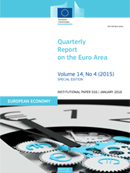|
|
|
|
|
|
|
|
|
|

|
 |
 |
 |
Banking Union: Single Resolution Mechanism comes into effect
A milestone in building the Banking Union for the Euro area was reached on 1 January 2016 when the Single Resolution Mechanism (SRM) became fully operational. The SRM implements the EU-wide Bank Recovery and Resolution Directive (BRRD) in the euro area. It will bolster the resilience of the financial system and help avoid future crises by providing for the timely and effective resolution of cross-border and domestic banks. The full resolution powers of the Single Resolution Board (SRB) also were applied as of 1 January 2016. The SRM Regulation stipulates that a Single Resolution Fund (SRF) be built up over a period of 8 years and pre-funded through contributions from the banking industry. Member States agreed to define some of the rules in an inter-governmental agreement that was ratified by a sufficient number of participating Member States on 29 November 2015. The Banking Union is mandatory for all euro area countries and open to non-euro area countries as well.
|
 |
 |
 |
|
 |
|
|
|

|

|
 |

|
President Juncker and College of Commissioners visit kicks off Dutch Presidency of the Council of the European Union
Marking the official launch of the Dutch Presidency of the Council of the European Union, President Juncker and the College of Commissioners paid their first official visit to the Dutch Presidency on 6-7 January. At the National Maritime Museum in Amsterdam President Juncker and Prime Minister Rutte met bilaterally, while the College and Dutch Cabinet members held "cluster meetings". During the meetings they discussed the five priorities outlined in the strategic agenda of the Dutch Presidency: Jobs, growth and competitiveness; the Economic and Monetary Union, financial services, social affairs and regional policy; the Energy Union, climate and transport; the EU as a strong global player; and finally, freedom, justice, security and counter-terrorism. Later, His Majesty King Willem-Alexander and Her Majesty Queen Máxima hosted a working lunch with the Commissioners at the Royal Palace in Amsterdam. The College then travelled to The Hague to meet with members of the Dutch Senate and House of Representatives.
|

|
|

|

|
|

|

|

|

|
December 2015: Business Climate Indicator increases slightly,
Economic Sentiment improves in the euro area and the EU
In December 2015, the Business Climate Indicator (BCI) for the euro area increased slightly (by 0.05 points to +0.41). Managers’ appraisals of total and export order books, as well as their production expectations improved. Past production, by contrast, was assessed slightly more negatively, while views on the current stock of finished products remained broadly unchanged. The Economic Sentiment Indicator (ESI) improved slightly in the euro area (by 0.7 points to 106.8) and more markedly in the EU (by 1.4 points to 108.9). Improved euro-area sentiment resulted from higher confidence in industry, which was only partially outweighed by lower retail trade confidence. Amongst the largest euro-area economies, the ESI rallied in Spain (3.4), increased slightly in Italy (+0.4) and remained broadly unchanged in Germany (+0.0) and France (-0.1). The Netherlands, by contrast, saw economic sentiment slipping (-2.4). The more pronounced increase of the headline indicator for the EU (+1.4) was the result of improved readings in the largest non-euro area economy, the UK (+2.9). In contrast, sentiment in Poland eased (-1.0).
|

|
|

|

|
|

|

|

|

|
ESM approves EUR 1 billion disbursement to Greece
On 22 December 2015, the Board of Directors of the European Stability Mechanism (ESM) authorised the disbursement of EUR 1 billion to Greece. This disbursement, which follows the Greek government’s completion of the second set of reform milestones, will be used by the government for debt service, budget financing, and co-financing projects funded by EU structural funds. The EUR 1 billion is the third and final disbursement from the initial loan sub-tranche of EUR 16 billion agreed in August 2015. The ESM has also disbursed EUR 5.4 billion to Greece for bank recapitalisation. Following the disbursement approved on 22 December, the total amount of ESM financial assistance for Greece will reach EUR 21.4 billion, which is around 25% of the initial programme volume of up to EUR 86 billion approved by the ESM Board of Governors on 19 August 2015.
|

|
|

|

|
|

|

|

|

|
December 2015: Euro area annual inflation stable at 0.2%
Euro area annual inflation is expected to be 0.2% in December 2015, stable compared to November 2015, according to a flash estimate published on 5 January by Eurostat, the statistical office of the EU. Looking at the main components of euro area inflation, food, alcohol & tobacco is expected to have the highest annual rate in December (1.2%, compared with 1.5% in November), followed by services (1.1%, compared with 1.2% in November), non-energy industrial goods (0.5%, stable compared with November) and energy (-5.9%, compared with -7.3% in November).
|

|
|

|

|
|

|

|

|

|
Unemployment rates decline: euro area at 10.5% and EU at 9.1%
The euro area seasonally-adjusted unemployment rate was 10.5% in November 2015, down from 10.6% in October 2015, and from 11.5% in November 2014. This is the lowest rate recorded in the euro area since October 2011. The EU unemployment rate was 9.1% in November 2015, down from 9.2% in October 2015, and from 10.0% in November 2014. This is the lowest rate recorded in the EU since July 2009. These figures were published by Eurostat, the EU statistical office. Among the Member States, the lowest unemployment rates in November 2015 were recorded in Germany (4.5%), the Czech Republic (4.6%) and Malta (5.1%), and the highest in Greece (24.6% in September 2015) and Spain (21.4%). Compared with a year ago, the unemployment rate in November 2015 fell in 25 Member States, remained stable in Romania and increased in Austria (from 5.6% to 5.8%) and Finland (from 9.0% to 9.4%). The largest decreases were registered in Spain (from 23.7% to 21.4%), Bulgaria (from 10.6% to 8.8%) and Italy (from 13.1% to 11.3%).
|

|
|

|

|
|

|

|
 |

|
Real Economy status check: how’s #InvestEU doing one year on?
The latest episode of "Real Economy" examines how the EU Investment Plan has done during its first year and what can be expected in 2016. The plan is devised to kick start investment in Europe, after investment levels dropped by about 15 percent between 2007 and 2013. The Investment Plan is expected to mobilise at least EUR 315 billion of additional private and public investment for the real economy. The European Fund for Strategic Investments (EFSI) provides an EU guarantee in support of projects financed by the EIB Group, incentivising private investors to participate in projects. As of January 2016, the Fund has already enabled EUR 2.8 billion in financing across a total of 21 projects in the infrastructure and innovation window, which is expected to trigger around EUR 13.3 billion in total investment. In the SME window, the Fund enabled EUR 1.5 billion in financing across a total of 66 operations, which is expected to trigger around EUR 21 billion in total investment. Real Economy explains the complexities of economic matters in the EU to Euronews' daily audience of 6.5 million viewers. Besides watching it on TV, viewers can also follow it online - live or on demand.
.
|

|
|

|
|
|
|
|
|
|

|

|

|

|
Quarterly Report on the Euro Area (QREA), Vol.14, No.4 (2015)
This edition of the QREA reviews the issue of shocks and adjustment in the light of recent crises. The analysis distinguishes between the factors that leave an individual economy particularly exposed to shocks, and features of EMU’s set up which may amplify the effects of certain shocks. It analyses the functioning of key internal adjustment processes in EMU: the relative price and real interest rate mechanisms. The report finds that Member States in comparatively weaker cyclical positions benefited from falls in relative costs and prices, but that the relative price mechanism has been slow to kick-in since the global financial crisis, while its stabilising function has been hampered by frictions in labour and financial markets. The report shows that financial fragmentation has exacerbated the de-stabilising effect of the real interest rate mechanism. Reviewing the different implications of high levels of indebtedness, the report finds that balance sheet consolidation can substantially prolong adjustment processes and introduce an asymmetry between debtor and creditor countries.
|

|
|

|
|
|
|
|
|

|

|
Export performance of Euro area countries 2010-2014 |

|

|

|

|

|

|

|
|
|
|
|
|
|
|
|
|
|
|
|
|

|
|
Directorate-General for Economic
and Financial Affairs
|

|
|